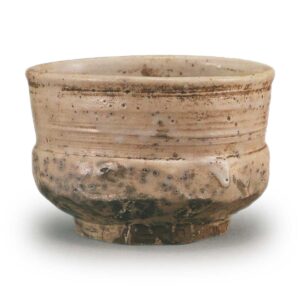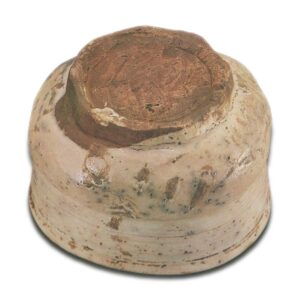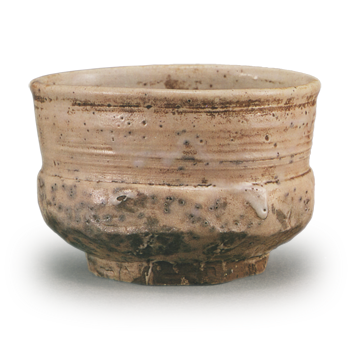

Height: 8.2cm
Diameter: 10.7-12.5cm
Height of foot ring: 8.0-8.2cm
Height of foot ring: 1.0cm
This is the one called the Fujiya Gosomaru, and although it had been stored in a secret place for many years and few people knew about it, it suddenly appeared at an auction held by the Fukuyama Fuji family, who were known as a famous family of tea ceremony enthusiasts in the Sanyo region, at the beginning of the Showa period, it was sold at a record-breaking price, surprising the world, and since then it has become known throughout the world as a twin jewel of the world of tea bowls, competing with the Furuta Koryu tea bowls that have been handed down in the Konoike family.
As is written in the book “Minsha”, Gosomaru is a so-called Oribe original, and its shape is completely unique to Oribe’s original design, unlike the original Korean tea bowls from Joseon. This ambitious design, which is unlike any other tea bowl, is more idealized in the Gosomaru tea bowl from Gimhae in Korea than in the Oribe tea bowls from Mino, the home of Oribe ware.
The Gosomaru was the traditional name of the official trading vessel used by the Muromachi shogunate for trade with Korea, but the legend that the name of the Gosomaru tea bowl originated from the fact that Oribe’s student Yoshihiro Shimazu had the tea bowls made in Gimhae using the same method as his teacher, and then presented them to Hideyoshi Toyotomi on board the Gosomaru, is probably based on fact. After that, it is thought that similar items or copies of the Gosho-maru were made in the early days of the Mamekouwa-yakata and also during the Busan kiln period.
The Fujiya Gosomaru is very similar to the Furuta Koryo and the Saku Yuki, and there are some aspects that make you think that the same potter may have made them. What stands out is the use of the spatula to scrape the waist and foot ring, and the careless touch is very similar. The Gosomaru kutsu-gata is based on the feeling of being mostly handmade, and the awkwardness of the local potters, who were not used to this kind of technique, even adds a kind of amateurish touch. The point of attraction in the Gosomaru with a white background is below the waist, but this seemingly amateurish, rough workmanship is actually the source of its charm.
Later, especially with the Gohonzoshimaru, the formalization of the style becomes more noticeable. The high-ground and waist-shaped parts of the Gohonzoshimaru are roughly cut to follow the outline of the original, and the interesting, carefree way in which the artist used the spatula to create the shape comes across vividly to the viewer appeal to people’s hearts, but in the case of works by formalized imitators, the multi-faceted foot ring and the beautiful tortoiseshell-patterned spatula have become tasteless works that are beyond redemption.
The Fujiyama Gosomaru bowl is full of a kind of unconventional beauty, and the so-called “heuge” style favored by Oribe is even more pronounced in this bowl. The shape is Oribe’s cut-out style, with a beaded rim, a body-tightening band, and a waistband, and the overall thickness is particularly impressive, with a dignified presence below the waist. The reddish color that is a characteristic of Kinkai Kente is particularly beautiful. The body has a lot of wheel marks and fine lines, and the bold brushstrokes around the waist are a major highlight.
The foot ring is imposing and has a strong, irregular nine-sided shape created by the strong, unplanned scraping. The scraping inside the foot ring is also plain and attractive. The scraping is a major characteristic favored by Oribe, and it can be said that it is most clearly demonstrated in the Gosomaru. The glaze is in the style of old Kote ware, and the surface is full of natural beauty, with uneven glaze, cracks, and missing pieces, and the fine purple stains on the inside and around the waist are beautiful.
In recent years, the name “Yuki” was added by the collector, Matsunaga Ji-an.



